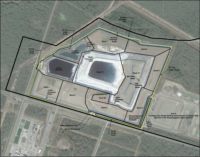Florida Gov. Ron DeSantis on April 13 directed the permanent closure of the industrial retention pond linked to a former phosphate manufacturing plant in Piney Point, Manatee County after the phosphogypsum waste reservoir began to fail earlier this month, causing the emergency disposal of millions of gallons of toxic wastewater into Tampa Bay.
DeSantis redirected $15.4 million for use of innovative technologies to treat elevated levels of phosphorous and nitrogen in reservoir water.
Florida Senate President Wilton Simpson said the legislature will appropriate $100 million initially to begin closure of the 676-acre waste storage site, with added funds by the end of the year to fully finance the shutdown. Simpson previously estimated the closure cost at $200 million.
A state Dept. of Environmental Protection (DEP) team of engineers and scientists will develop a plan to close the site, said DEP Secretary Noah Valenstein. “This plan will ensure this closure is the last chapter in the long history of Piney Point,” he said.
DEP also established a legal team to hold accountable HRK Holdings, which has owned the property since 2006, and any other corporations or individuals, for recent problems at the reservoir, Valenstein said. HRK purchased the property from the state DEP for $4.3 million, with the requirement that it maintain the phosphogypsum containment facility, known as a "stack," and contaminated wastewater left from the plant's former operations.
Florida handles about 25% of global phosphate mining, and 80% of U.S. production, according to U.S.Environmental Protection Agency data. with about 23 million tons mined and consumed annually in the U.S. .
First Step
Environmental advocacy group Earthjustice said the Florida plan was a first step, but it needs to investigate other such phosphate waste sites in the state. “At this point, there’s no excuse for any of these phosphate facilities to escape scrutiny,” the environmental group said.
HRK Holdings employees reached by phone said they were not in a position to comment on DeSantis’ plan for closure. The firm said in an earlier statement to The Free Press that it was working with federal, state and county officials to manage the discharge.
HRK had claimed that the “defective lining,” which also failed in 2011, was installed before it acquired the property, and that the original design and installation of the liner led to the failures.
The DeSantis order followed an emergency drawdown of the retention pond on April 6, which sufficiently reduced the risk of a catastrophic failure that threatened adjacent homes and businesses, state and local authorities said.
Ron DeSantis had issued a State of Emergency on April 3, prompting evacuation of an estimated 316 nearby households. That emergency declaration was lifted April 6.
The retention pond had held 480 million gallons of wastewater
Reducing Pressure
In early April, crews began pumping water out of the pond to reduce pressure on surrounding berms, which authorities feared could fail. Controlled discharges were released into Port Manatee, which feeds directly into Tampa Bay, prompting concerns that the contaminants could fuel an algae bloom.
“I hate to see what’s happened in terms of algae bloom and red tide, not just here but across the state,” said Rep. Vern Buchanan (R-Fla.) on April 5. “When I see water flowing into Tampa Bay, frankly it makes me sick.”
As of April 6, 26 pumps and vacuum trucks were removing more than 35 million gallons of water from the pond per day. About 300 million gallons of water remain in the damaged pond.
An ongoing concern with the integrity of the berms is a concentrated area of seepage in one section of wall. Jacob Saur, Manatee County director of public safety, announced April 6 that seepage rates had decreased. Another area that was discharging into a nearby creek is now under control.
Saur added that a report provided by the U.S. Army Corps of Engineers on April 6 showed the potential for “much lower flow in terms of volume and velocity, across the entirety of the affected area should a breach occur.” The potential area of inundation would be farmland, lakes and lowlands, he added.
Kevin Guthrie, deputy director at the Florida Division of Emergency Management, said roughly 75 state employees and contractors have been deployed to the site in recent days. Drone teams fly around the site at regular intervals to gather real-time data for ongoing investigations.
He said crews also were deploying a remotely operated submersible vehicle to find leaks and help the team come up with temporary patches. Bathymetric Lidar may also be deployed to scan the liner.
“Our goal is to buy the Dept. of Environmental Protection time,” he said.
Among the possible long-term solutions, the county board unanimously authorized the use of a deep injection well on county-owned property near the Piney Point site, said Vanessa Baugh, chair of the Manatee County Commission. The authorization gives commissioners “total control over the well,” including the ability to set water quality standards.
“Residents and business owners of North Manatee can rest assured that the water will be treated before it goes into the well and then capped to ensure that no other water enters that well,” she said.
Piney Point has a decades-long history of spills and leaks. Buchanan said HRK “needs to be held completely responsible.”





Post a comment to this article
Report Abusive Comment